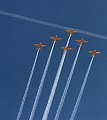
God BlessAmerica |

God BlessAmerica |
New York |
Washington DC |
 |
 |
 |
 |
 |
 |
 |
 |
 |
 |
 |
 |
 |
 |
 |
 |
 |
 |
 |
 |
 |
 |
 |
 |
 |
 |
 |
 |
 |
 |
 |
 |
 |
 |
 |
 |
 |
 |
 |
 |
 |
 |
 |
 |
 |
 |
 |
 |
 |
 |
 |
 |
 |
 |
 |
 |
 |
 |
 |
 |
 |
 |
 |
 |
 |
 |
 |
 |
 |
|||
| The Thunderbirds
The U.S. Air Force Air Demonstration Squadron, the Thunderbirds, performs precision aerial maneuvers demonstrating the capabilities of Air Force high performance aircraft to people throughout the world. The squadron exhibits the professional qualities the Air Force develops in the people who fly, maintain and support these aircraft. The Thunderbirds squadron is an Air Combat Command unit composed of eight pilots (including six demonstration pilots), four support officers, three civilians and more than 130 enlisted personnel performing in 25 career fields. The Lockheed Martin (formerly General Dynamics) F-16 Fighting Falcon represents the full range of capabilities possessed by the Air Force's tactical fighters. This highly maneuverable multi-role fighter has proven itself to be one of the world's best precision tactical bombers and air-to-air combat aircraft. The only modifications needed to prepare the aircraft for its air demonstration role are installing a smoke-generating system in the space normally reserved for the 20mm cannon, and the painting of the aircraft in Thunderbird colors. The F-15 Eagle
The B-1B Lancer The B-1B's blended wing/body configuration, along with variable-geometry design and turbofan engines, combine to provide greater range and high speed with enhanced survivability. Forward wing settings are used for takeoff, landings and high-altitude maximum cruise. Aft wing settings are used in high subsonic and supersonic flight, enhancing the B-1B's maneuverability. The B-1B's speed, superior handling characteristics, and large payload make it a key element of any joint/composite strike force. The B-1B's offensive avionics include the forward-looking offensive radar set employing synthetic aperture radar, ground moving target indicator and terrain-following radar modes, an extremely accurate Global Positioning System/Inertial Navigation System, the avionics control unit complex, a Doppler radar, and a radar altimeter. These features enable aircrews to globally navigate, accurately refine aircraft position without the need for ground-based navigation aids, update mission information and target coordinates in-flight, and perform precision bombing. The B-1B's electronic jamming equipment, infrared countermeasures, radar location and warning systems complement its low-radar cross-section and form an integrated defense system for the aircraft that supports penetration of hostile airspace. The current defensive avionics system consist of the ALQ-161A radio frequency surveillance/electronic countermeasures system, the tail warning function, and the expendable countermeasures system, and is supplemented by the ALE-50 Towed Decoy System. The defensive avionics system is a comprehensive electronic countermeasures package that detects enemy threats and applies the appropriate countermeasures, such as electronic jamming or dispensing expendable chaff and flares to protect against radar-homing and heat-seeking missiles. The TDS complements the system by providing greater protection against RF threats. Low-radar cross-section is provided by the combination of aircraft structure and radar-absorption materials that reduce the aircraft's radar signature to approximately 1 percent that of the B-52. Similar to the offensive avionics, the defensive suite has a reprogrammable design that allows in-flight changes to be made to counter new or changing threats. The ongoing Conventional Mission Upgrade Program is significantly enhancing the B-1B's capability. This gives the B-1B greater lethality and survivability through the integration of precision and standoff weapons and a robust electronic countermeasures suite. The upgrade program includes GPS receivers, a weapons interface which enables the use of the joint direct attack munition and other weapons, secure radios, and improved computers to support new precision and near-precision weapons such as the wind-corrected munitions dispenser, the joint standoff weapon, the joint air-to-surface standoff missile. These improvements help lay the foundation for future precision miniature munitions, such as Small Diameter Bomb. The defensive system upgrade will greatly improve aircrew situational awareness and its electronic countermeasures capability. Through the replacement of the current ALQ-161 with the ALQ-214 Integrated Defensive Electronic Counter-Measures, and ALE-55 Fiber Optic Towed Decoy, the B-1 will be able to detect and defeat lethal threats well beyond the 2010 timeframe. |
Back
To Photography ROW